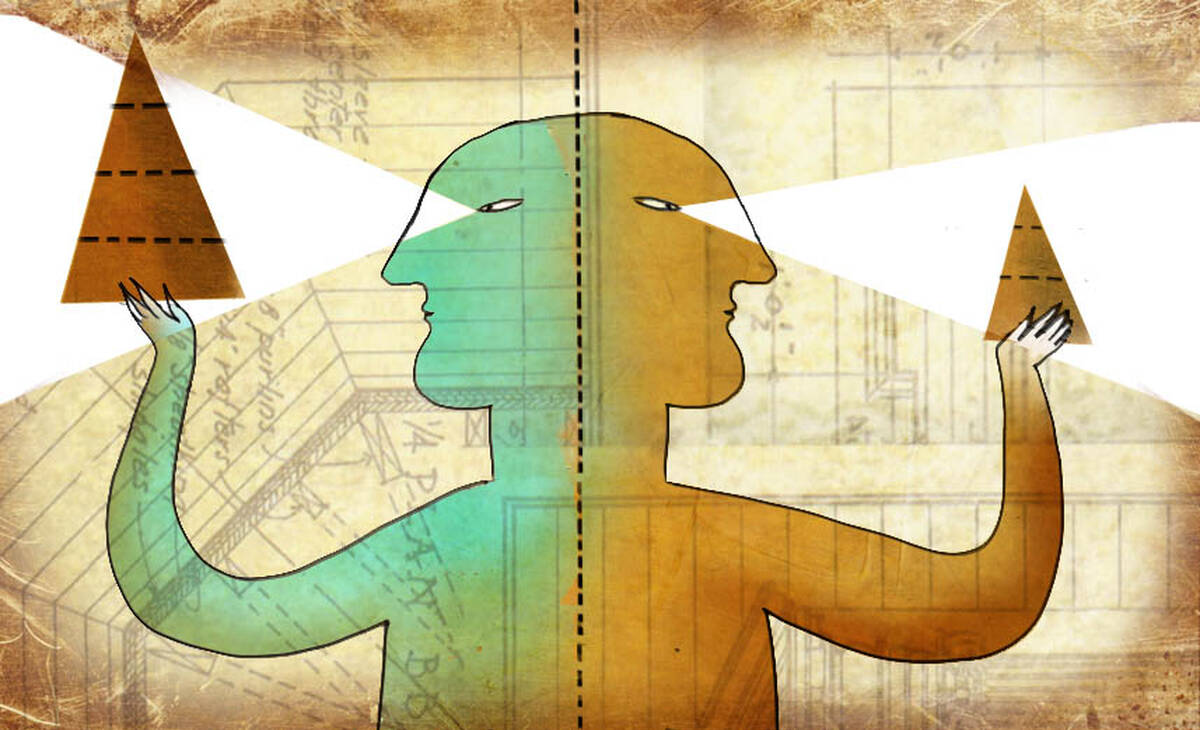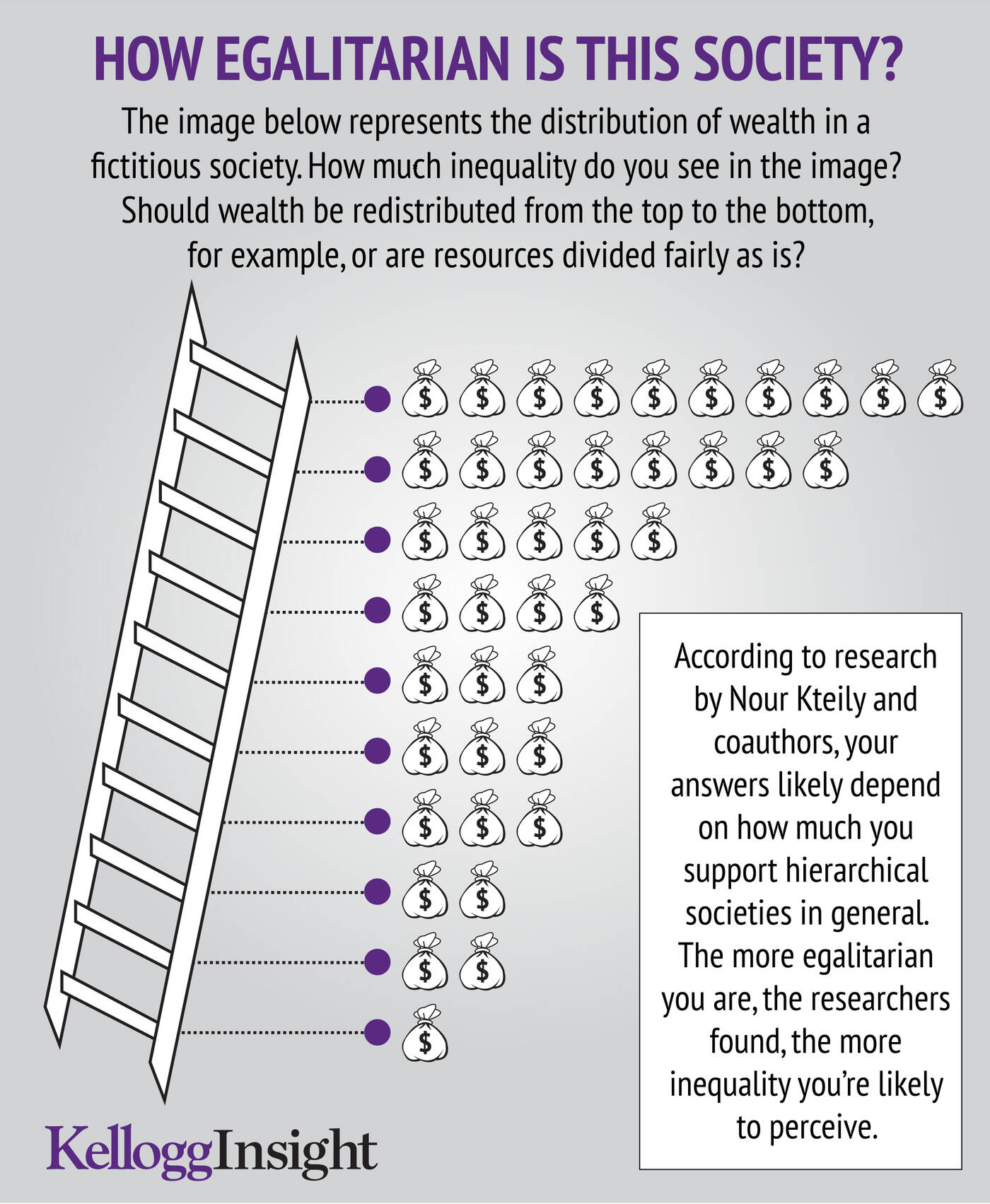Featured Faculty
Professor of Management & Organizations; Kellogg Chair in Enlightened Disagreement; Co-Director of the Dispute Resolution Research Center; Co-Director of the Center for Enlightened Disagreement

Yevgenia Nayberg
Imagine a company striving to ensure adequate gender representation among its staff. Managers must decide how to pursue a balanced ratio of men and women. No doubt there will be disagreements about which factors are driving the disparity and how to address it.
But new research from the Kellogg School suggests that a subtler underlying problem may make such thorny issues even harder to resolve: people who support egalitarianism tend to see more inequality, while those who prefer hierarchical systems see less inequality. In other words, not only would these two groups likely clash over causes and solutions, but they may not even agree on the severity of the problem—in this case, just how skewed the organization’s gender ratio actually is.
These differences are likely compounding struggles to address equality-related issues, says Nour Kteily, an assistant professor of management and organizations at the Kellogg School of Management.
“There’s already variation in people’s beliefs about the desirability of hierarchy” and their explanations for why inequality exists, he notes. “It’s an even worse problem if people are starting from a different baseline about how much inequality there actually is.”
“There’s bias across the spectrum. This is something everyone needs to consider.”
Kteily’s research found this pattern holds across several social contexts, such as inequality in gender, race, and class—and even when participants were presented with fictional group conflicts or abstract images that simply evoked unequal distribution of power and resources.
Since distorted perceptions were seen among both egalitarians and anti-egalitarians, the blame cannot be placed solely on one side. “There’s bias across the spectrum,” he says. “This is something everyone needs to consider.”
Researchers have previously examined how people rationalize social inequality. These studies suggest, for example, that people who prefer social hierarchies also tend to support ideologies that bolster the legitimacy of the more powerful group’s position. Think of the justifications built into racism, nationalism, or even karma, which attributes someone’s lot in life to his or her previous actions. However, little work has been done to explore whether people’s beliefs about hierarchy affect how much inequality they perceive in the first place.
Kteily and his collaborators, Jennifer Sheehy-Skeffington at the London School of Economics and Political Science and Arnold Ho at the University of Michigan, conducted a series of studies to investigate. For each experiment, the team recruited people online and asked them questions to assess their “social dominance orientation” (SDO), a measure of how much they favor social hierarchy. A person with high SDO would agree that it is acceptable for some groups to dominate others and would reject the idea that every group should have equal opportunities; a person with low SDO would believe the opposite.
In the first study of 649 participants, the researchers, after assessing SDO levels, asked each person to rate on a scale of 1 to 7 how much power various groups in society possessed: white Americans, black Americans, men, women, and people born into rich, middle-class, or poor families. The team then calculated the gaps between groups to determine, for example, participants’ perceptions of the power disparity between men and women.
Egalitarians tended to report larger discrepancies in power, the team found. Participants who scored in the lowest quartile on SDO—that is, those who were the most egalitarian—estimated that dominant groups— for example, men, white Americans, and the rich—were an average of 2.67 points more powerful than weaker groups—for example, women, black Americans, and the poor. Meanwhile, people who scored in the highest quartile on SDO reported an average power gap of only 1.05 points.
But the study raised a question: Was this pattern occurring simply because egalitarians were exposed to more inequality, while people who believe in hierarchy did not see many examples of it in their daily lives? A person with low SDO might be a social worker who frequently saw injustices suffered by minorities. Meanwhile, a high-SDO individual could be a corporate executive who did not encounter such situations frequently.
If that were the case, the egalitarians and anti-egalitarians would not actually be perceiving different levels of inequality in the same situation. They would just be reporting the inequality they saw in their respective environments. In that scenario, “no one’s processing information differently,” Kteily says. “They’re just processing different information.”
To distinguish between the two possibilities, Kteily’s team asked 153 participants to read a fictional scenario about a power imbalance. In this story, two groups in a made-up country named Raga battle over land, and one group ultimately dominates. As in the first study, the participants rated the amount of power each group possessed.
The results were the same: people with egalitarian leanings saw a bigger power gap than did people who preferred hierarchical societies. In other words, the participants reported different perceptions of the same, fictional information.
Kteily suspects this discrepancy arises because the two groups focus on different details. For instance, an egalitarian might pay more attention to how the dominant group in Raga had taken resources away from the weaker group. Meanwhile, an anti-egalitarian might zero in on the weaker group’s potential to fight back.
The researchers found similar results even after showing participants only abstract pictures representing fictional societies and organizations. In one study, the images were ladders with different numbers of moneybags next to the rungs; in another, the images were layered pyramids with different numbers of stick figures at each level. For each picture, the participants rated how strongly they agreed with statements such as “The distribution of money in this society is very unequal” or “There is not a big difference in the distribution of power from the bottom to the top of this organization.” Again, egalitarians reported bigger power discrepancies than anti-egalitarians.
To reduce the possibility that people were deliberately misreporting their perceptions, the researchers offered a $12 bonus to participants who rated the power gaps the most accurately. “It made absolutely no difference whatsoever,” Kteily says.

Collectively, the studies suggest that people indeed perceived the same information differently. But who is to blame? Was one group seeing the “correct” amount of inequality, while the other side was overestimating or underestimating it? Or were both groups biased?
In the final study, Kteily’s team explored this question by giving 539 participants a memory test. First, the participants were shown pictures of organizational pyramids with different degrees of hierarchy; for instance, some of the pyramids had more layers than others, and some had flatter organizational structures. Next, the researchers asked each person to recall which images they had already been shown. Participants were then presented with sets of pictures. Each set contained an image the person had already seen and four similar versions, two that were more egalitarian and two that were more hierarchical.
People who preferred hierarchical systems tended to remember seeing less inequality than they had actually seen. Similarly—although the link was weaker—egalitarians tended to overestimate the amount of hierarchy they had previously seen. This suggests that people’s motivations are coloring their perception of the world, Kteily says. Egalitarians, who want to bring attention to inequality, perceive large discrepancies in line with their call to action. Anti-egalitarians, who worry that there will be pressures to equalize society if power gaps are highly visible, perceive smaller differentials, consistent with their arguments that no intervention is needed.
Kteily notes that the experiments were done in the U.S., a society with egalitarian norms, and that results might differ elsewhere. In India, say, where the hierarchical caste system is more broadly accepted, people might generally be more tolerant of inequality, weakening anti-egalitarians’ motivation to perceive smaller power gaps. And while the online participants covered a fairly wide range of political orientations, SDO levels, and societal classes, they likely did not include people at extreme ends of the economic spectrum.
What can be done about the problem? Kteily suggests taking a step back and recognizing one’s own biases.
“Being mindful of the fact that we might be seeing things through tinted lenses can be helpful,” he says. For example, if you are fervently pushing or rejecting an equality-related measure and getting frustrated with your opponents, acknowledge that neither of you may be entirely correct. “It promotes a little bit of humility with respect to your perspective,” he says.
That does not mean that people should completely dismiss their own perceptions. “I wouldn’t want my message to be, ‘You’re imagining things,’” Kteily says. “There might very well be a problem. But it’s possible that you are also perceiving one that’s a little bit more extreme than the reality warrants, and that the reverse is probably true of your counterpart.”
Kteily, Nour S., Jennifer Sheehy-Skeffington, and Arnold K. Ho. 2016. “Hierarchy in the Eye of the Beholder: (Anti-) Egalitarianism Shapes Perceived Levels of Social Inequality.” Journal of Personality and Social Psychology. doi: 10.1037/pspp0000097.